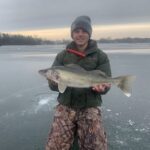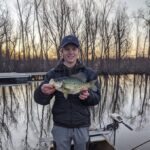Hey there anglers! When most people think of walleye fishing, they tend to think about rocks and deep water. Fisherman seldom think about weeds when it comes to walleye fishing. Contrary to popular belief, walleye relate to weeds throughout the entirety of the year. With that being said, there are a few nuances to be aware of to improve your chances of success on the water. Whether you’re a seasoned pro or a newbie, we’re here to unravel the secrets of weed walleye fishing together!
As always, fishing education and conservation are our priorities here at The Angler’s Line. Feel free to sign up for our free newsletter to join our community and stay up to date! Lets get started!
Table of Contents:
- Why Walleye Relate To Weeds
- Gear
- Lures
- Techniques
- Which Weeds To Target
- When To Fish Weeds
- Conservation
Understanding Why Walleye Relate To Weeds
Ever wondered why walleye relate to the weeds? Understanding this key question can help you determine what to look for on your next trip. The two main reasons walleye relate to the weeds are for shade and forage. Weeds provide shade which is important for walleye since their eyes are sensitive to light.
Perhaps one of the main reasons walleye relate to vegetation however is to feed on baitfish. It is well known that baitfish seek cover in weeds. Where there is bait, there are usually walleye. Be sure to understand the various types of walleye forage to help narrow your search.
Essential Gear for Weed Walleye Fishing: Set Yourself Up for Success
Now, let’s talk gear. It’s like choosing the right tool for the job – especially when fishing weeds
Rod
When fishing for walleye in the weeds, I recommend a stiffer rod. I’ve experimented with a variety of rod lengths and powers over the years, and my favorite all around model is a medium power between 6’6″ and 7′ in length. Generally when you are fishing weeds, you need a slightly stiffer rod to break your lure free, hence the medium power. A slightly shorter rod is ideal since it prevents fatigue over a long day of fishing.
Line
As far as line goes, I am a proponent for a braided main line to a fluorocarbon leader. Typically a braided line between 15-20 lb test and a fluorocarbon leader between 8-12 lb test is a good starting point. Braid works well since it tends to cut through weeds better than other lines.
Best Lures For The Weeds
Not all lures will work in this situation. Make sure to select a lure that is designed for the job.

Crankbaits
Casting shallow crankbaits is a great way to cover water and find pods of walleyes in the weeds. Choose a crankbait that dives within a foot or two of the tops of the weeds you are fishing. Don’t worry if your crankbait snags up on a few weeds here and there. Rip the lure free and then pause it. A lot of your strikes will occur on this pause.
Plastics
A jig and plastic is another great lure option that excels in vegetation. The key difference here is to use a snap jigging retrieve. This aggressive retrieve allows you to break through all of the vegetation instead of it collecting on your hook. Use a heavier jig than normal and beef up your equipment. This is a reaction strike, so don’t be worried about finessing the walleye into biting.
Live Bait
Although you can catch plenty of fish on artificial lures, there is always a time and place for it live bait walleye fishing. The main types of live bait for walleye include minnows, leeches, and nightcrawlers. Choose your live bait depending on the season you are fishing. Some of my favorite live bait rigs for vegetation include a crawler harness and a slip bobber. A crawler harness works well along weed edges and allows you to cover water by trolling. Once you find a school of fish, a slip bobber is a great option to hang the live bait vertically over the fish to pick up a few more.
Bonus Tip: If you are snagging weeds a little too much with the crawler harness, try switching to a floating crawler harness.
As always, don’t be afraid to mix things up on the water. Constantly change your lure and retrieve until you find something that works.
Techniques to Tackle the Weeds: Working Your Lures Like a Pro
Snap Jigging
The snap jigging retrieve has all but revolutionized walleye fishing in recent years. As I mentioned before, the benefit of snap jigging is that it allows your jig to break through the weeds as opposed to getting stuck in them. Let your bait reach bottom before aggressively ripping it several feet off bottom. Let the bait go back to bottom on slack line and repeat. Almost all of your strikes will occur on the drop. Heavy jigs and plastics or hair jigs work best are my two favorites for this technique.
Trolling
Trolling for walleye is one of my go to strategies when I am targeting a weed edge. Walleye may be buried in the weeds during the day but move towards the edge during low-light conditions. This is a prime time to troll and cover some water. Either troll with a crawler harness rig or crankbaits, keeping your lure within a few feet of bottom.
Vertical Jigging
The advantage of vertically jigging is that you can keep your presentation up and out of the weeds. This technique works best when the vegetation is in deeper water to prevent your boat from spooking fish underneath. Use a jig with your choice of live bait and keep it right over the tops of the weeds. This is not a technique that covers a lot of water so be sure to use your electronics to locate a pod before wetting a line.
Reading the Weeds: Some Weeds Are Better Than Others
Green Weeds
First things first, it is important that the weeds you are targeting are green. Avoid targeting dead and brown weeds. Dead weeds will not produce oxygen and provide minimal shade, making them much less desirable to all species of fish. Additionally, pay attention to the different types of weeds and learn about the best weeds for fishing.
Location
The location of the weeds is another critical component. Most of the time I focus on weed beds in close proximity to deep water. One exception to this is spring, where walleye can be found extremely shallow and can be caught from shore. In general however, focus on flats that dump out into the main basin. Points, humps, and steep breaks are all great areas to look out for.
When Is The Best Time To Target Weeds?
As I mentioned earlier, walleye can be found relating to weeds throughout the entire year. At the same time, your chances of catching walleye in the weeds is definitely better at certain times of day. I have found that low-light conditions improve your chances of success considerably. I think that walleye hunker deep in the weeds during the day but come out to feed when the sun goes down. Another thing to look out for is heavy winds. Strong winds can push baitfish into cover. This attracts walleye from deeper water into these shallower weedy areas. Fish the windward side of structure during or directly after strong winds for the best chances of success.
Conservation and Ethical Fishing Practices
As responsible anglers, it’s crucial to prioritize conservation and practice ethical fishing
Catch and Release
Adhere to catch-and-release guidelines whenever possible to preserve the walleye population for future generations. Handle fish with care, use barbless hooks to minimize injury, and return them to the water as quickly and gently as possible. If you plan on keeping a few fish for a meal, release the larger fish to let them spawn.
Regulations and Limits
Stay informed about local fishing regulations and adhere to size and bag limits. These limits are in place to ensure sustainable fish populations and healthy ecosystems. Ignorance is no excuse, so take the time to familiarize yourself with the specific regulations in the areas you fish.
Leave No Trace
Respect fish and wildlife habitats by minimizing your impact and leaving the environment as pristine as you found it. Dispose of any trash properly and consider participating in organized shoreline cleanups. Respecting nature and its resources is crucial for future generations of anglers to enjoy.
And there you have it, fellow anglers – everything you need to know about walleye fishing in the weeds. From understanding why they use to weeds to the different lures and techniques to fish them effectively, you’re armed with the knowledge you need. So, next time you’re out on the water, don’t overlook the weeds. Remember these tips, embrace the challenge, and put your newfound knowledge to the test. Tight Lines!
- The Ultimate Kids Fishing Guide

- Ice Fishing For Walleye: Everything You Need To Know

- Midday Walleye: A Complete Breakdown Of Daytime Walleye Fishing

- Live Bait For Walleye: Everything You Need To Know

- Lure Talk: Full Guide On Fishing Crankbaits For Walleye

- Lure Talk: Best Crappie Lures For Each Season

